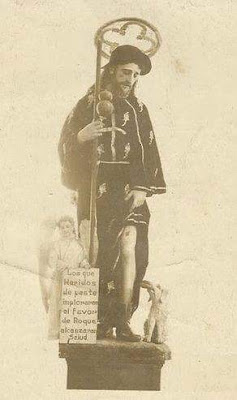San Roque de Caloocan - The Patron of Caloocan City
 |
| San Roque de Caloocan |
Of all the images of San Roque in the country, arguably that of San Roque in Kalookan Cathedral is one of the most recognizable in the country in modern times. Due to the popularity and importance of San Roque to the people of Caloocan, the Holy See chose his humble abode to be the Seat of the Diocese of Kalookan where he became the watchful patron of the diocese.
The image
The image of San Roque is that of a middle aged man from the medieval period wearing his pilgrim attire. The image of San Roque de Caloocan is that of a serene bearded face that capture the attention of its beholder. Although the image was done in de-tallado style of carving, he is presented to the faithful vested in fine clothing given by his devotees over the years.
St. Roch of Montpelier was born in Montpelier, France to a wealthy parents where his father is the governor of the place. He was orphaned when he was twenty and he went on pilgrimage to Rome and devoted himself to caring for the victims of a plague that was ravaging Italy. He became a victim himself at Piacenza but recovered and was reputed to have performed many miracles of healing. On his return to Montpellier, he was imprisoned for five years for he was suspected as a spy in pilgrim's disguise by his uncle, who was governor. (His uncle failed to recognize him, and Roch failed to identify himself.) Roch died in prison and was only then identified as the former governor's son by a birthmark in the form of a cross on his chest. When miracles were reported at his intercession after his death, a popular cult developed and he is invoked against pestilence and plague. He is also the patron of invalids. His feast day is August 16.
Much like its co-patron, the Nuestra Señora de la Nieva, the origins of the image was said began in 1765 where it is said that Rev. Fr. Manuel Vanquero, Parochial Vicar of Santo Niño de Tondo Parish, gave the community two statues, that of San Roque and the Nuestra Señora de la Nieva from Talavera, Spain. During that year, the chapel was being built to nourish the faith in Libis Aromahan (now part of Caloocan).
On April 8, 1815, the Archbishop of Manila, Most Rev. Antonio de Zulaivar, canonically erected the San Roque Parish, separating them from the Santo Niño de Tondo Parish. Rev. Fr. Manuel de San Miguel was their first parish priest, as the building was transfered from Libis Aromahan to Paltok, the church’s present site. In 1819, Rev. Fr. Vicente de San Francisco Xavier paved the way for the construction of a bigger church, which was completed in the administration of Rev. Fr. Cipriano Garcia.
 |
| San Roque Cathedral, Caloocan City |
After the war that harmed several communities, Rev. Fr. Victor Raymundo initiated the reconstruction of the church, with the Confradia de Sagrado de Corazon de Jesus leading the way. After Fr. Raymundo’s term, several parish priests, namely Rev. Frs. Eusebio Carreon, Pedro Abad, and Pedro Vicedo contributed to the task of revitalizing the old building. In 1977, Rev. Msgr. Augurio Juta planned for a bigger church, it was only in the mid–1980, in the tenure of Rev. Msgr. Boanerges Lechuga’s term that the renovations and restorations were completed.
 |
| Dalaw Patron of San Roque de Caloocan |
The Devotion
The devotion to San Roque of Caloocan flourished over the past centuries up to the present. Aside from the annual fiesta of San Roque every August 16, the "Dalaw Patron" tradition began during the Bicentennial Jubilee of San Roque Cathedral. The image that was used for this tradition is a smaller image of San Roque de Caloocan found at the back of the cathedral was brought to the different chapels in the area within the territories of Caloocan Cathedral that would culminate with a Traslacion from Libis Espina, the original site of the visita to it's present site.
It is only fit for a community beset with political, social, economical and environmental woes to have San Roque as a patron. In perilous times, we can always ask him to pray for us to the God.
References:
Pirlo, Paolo, SHMI (2001), A Year with the Saints, Sons of Holy Mary Immaculate, Isabella de Rosis St., Multinational Village, Paranaque City.
San Roque: Brief History, Retrieved from http://kalookandiocese.org/parishes/vicariate-of-san-roque/san-roque-cathedral.html on August 1, 2018.
San Roque: Brief History, Retrieved from http://kalookandiocese.org/parishes/vicariate-of-san-roque/san-roque-cathedral.html on August 1, 2018.
Special thanks to Mr. Jose Miguel "Mico" Pacheco for documents and photos of San Roque de Caloocan that were utilized for this blogpost. +AM+DG+







Comments
Post a Comment